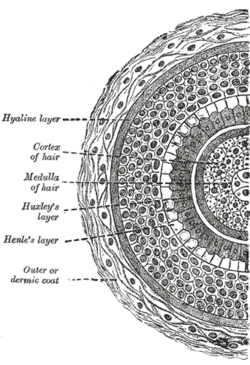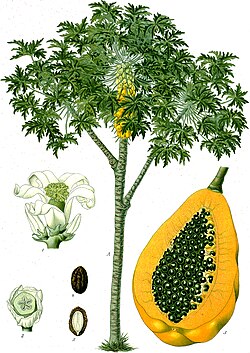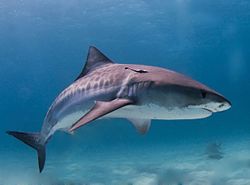A dimorphic root system is a plant root system with two distinct root forms, which are adapted to perform different functions. One of the most common...
1 KB (167 words) - 21:47, 5 December 2023
harbor nitrogen-fixing cyanobacteria. They are only found in cycads. Dimorphic root systems: roots with two distinctive forms for two separate functions Fine...
52 KB (6,158 words) - 20:02, 11 June 2025
Dimorphism (redirect from Dimorphic)
dimorphism in Wiktionary, the free dictionary. Dimorphism or dimorphic may refer to: Dimorphic root systems, plant roots with two distinctive forms for two separate...
987 bytes (152 words) - 02:50, 8 May 2019
Hair (redirect from Root of the hair)
ISBN 0674639413. Scott, Isabel M. (7 October 2014). "Human preferences for sexually dimorphic faces may be evolutionarily novel". Proceedings of the National Academy...
75 KB (8,484 words) - 03:36, 2 June 2025
connections are known. In this species, the nervous system is sexually dimorphic; the nervous systems of the two sexes, males and female hermaphrodites...
73 KB (9,361 words) - 07:36, 13 April 2025
Banksia prionotes (section Breeding system)
(1996). "Seasonal water uptake and movement in root systems of Australian phraeatophytic plants of dimorphic root morphology: a stable isotope investigation"...
65 KB (7,152 words) - 22:09, 15 November 2024
Flower (redirect from Pollinator attraction system)
Mazer, Susan J. (2019). "Heteranthery in Clarkia: pollen performance of dimorphic anthers contradicts expectations". American Journal of Botany. 106 (4):...
81 KB (8,405 words) - 17:38, 12 June 2025
Leprosy (redirect from Leprosy, dimorphic)
make marriage to a person infected with leprosy punishable. The Hebraic root tsara or tsaraath (צָרַע, – tsaw-rah' – to be struck with leprosy, to be...
134 KB (13,397 words) - 17:14, 13 June 2025
Androdioecy (category Sexual system)
gynodioecy are sometimes referred to as a mixed mating systems. Androdioecy is a dimorphic sexual system in plants comparable with gynodioecy and dioecy. The...
22 KB (2,100 words) - 11:07, 21 January 2025
Radopholus similis (redirect from Banana-root nematode)
therefore can cause many localized necrotic patches throughout an infected root system. R. similis signs are generally only seen in the roots, but secondary...
13 KB (1,566 words) - 15:39, 25 May 2025
Man (section Reproductive system)
which have no direct link to reproductive ability. Humans are sexually dimorphic in body size, body structure, and body composition. Men tend to be taller...
57 KB (5,525 words) - 12:25, 25 May 2025
a limited time, floral formation and leaves (see also Indeterminate). Dimorphic – of two different forms. Ecad – a plant assumed to be adapted to a specific...
82 KB (10,361 words) - 12:21, 6 June 2025
Congenital red–green color blindness is an inherited condition that is the root cause of the majority of cases of color blindness. It has no significant...
36 KB (3,281 words) - 16:42, 9 January 2025
blend well with wet and shiny green area. They are strongly sexually dimorphic, and parts of the females' plumage are brown or grey. The tails of the...
11 KB (1,245 words) - 00:39, 26 May 2025
Their ability to thrive in low levels of nutrients is facilitated by its dimorphic developmental cycle. The swarmer cell has a flagellum that protrudes from...
26 KB (3,357 words) - 22:10, 2 December 2023
after an injury to the brain tissues. Surgical alteration of sexually dimorphic skull features may be carried out as a part of facial feminization surgery...
42 KB (4,843 words) - 19:03, 4 June 2025
zygomatic bones and rounded molars and premolars. They also were sexually dimorphic and may have been capable of swimming with both or either pair of flippers...
108 KB (12,930 words) - 14:17, 9 June 2025
Beetle (redirect from Respiratory systems of beetles)
move food into the mouth. In many species, the mandibles are sexually dimorphic, with those of the males enlarged enormously compared with those of females...
156 KB (17,079 words) - 15:29, 2 June 2025
period of time. They are usually large herbaceous plants with rhizomatous root systems and lacking an aerial stem except when flowering. Flowers are usually...
48 KB (4,349 words) - 16:06, 8 June 2025
Snake (redirect from Reproductive systems of snakes)
identify the sex of a snake when the species is not distinctly sexually dimorphic by counting scales. The cloaca is probed and measured against the subcaudal...
152 KB (15,035 words) - 18:01, 2 June 2025
leaves Leaf Papayas are dioecious. The flowers are five-parted and highly dimorphic; the male flowers have the stamens fused to the petals. There are two...
37 KB (3,916 words) - 20:57, 2 June 2025
may use this to attract mates and in territorial displays. In sexually dimorphic signalling, as in the brown ghost knifefish (Apteronotus leptorhynchus)...
32 KB (2,961 words) - 06:30, 23 May 2025
leaves, and stems as in most other angiosperms. Utricularia lack a root system. Bladder traps are recognized as one of the most sophisticated structures...
41 KB (4,955 words) - 19:37, 25 May 2025
polyandrous Gulf pipefish (Syngnathus scovelli) displays considerable sexual dimorphic characteristics such as larger ornament area and number, and body size...
20 KB (2,152 words) - 17:04, 14 January 2025
Association's all-tackle record is 810 kg (1,790 lb). It is sexually dimorphic, with females being the larger sex. Mature females are often over 3.7 m...
52 KB (5,440 words) - 13:22, 9 June 2025
recruitment and population expansion is typically reliant on wildfire, but a dimorphic population of both dormant and as well as germinable seeds are prepared...
22 KB (2,397 words) - 00:49, 28 March 2025
John N. Stellflug and Fred Stormshak (2004). "The Volume of a Sexually Dimorphic Nucleus in the Ovine Medial Preoptic Area/Anterior Hypothalamus Varies...
41 KB (3,348 words) - 22:12, 23 May 2025
quickly to any rainfall, helped by an extensive but relatively shallow root system that quickly absorbs any water reaching the ground surface. Cactus stems...
109 KB (12,456 words) - 10:17, 12 June 2025
to spikes: A newfangled reconstruction of the ancient, giant, sexually dimorphic Pacific salmon, †Oncorhynchus rastrosus (SALMONINAE)". PLOS ONE. 19 (4)...
159 KB (10,949 words) - 05:29, 4 June 2025
These infertile stamens are termed staminodes. The fertile stamens are dimorphic: the lateral pair have maroon to indigo anthers that measure about 2 mm...
34 KB (4,112 words) - 20:47, 7 November 2024

























